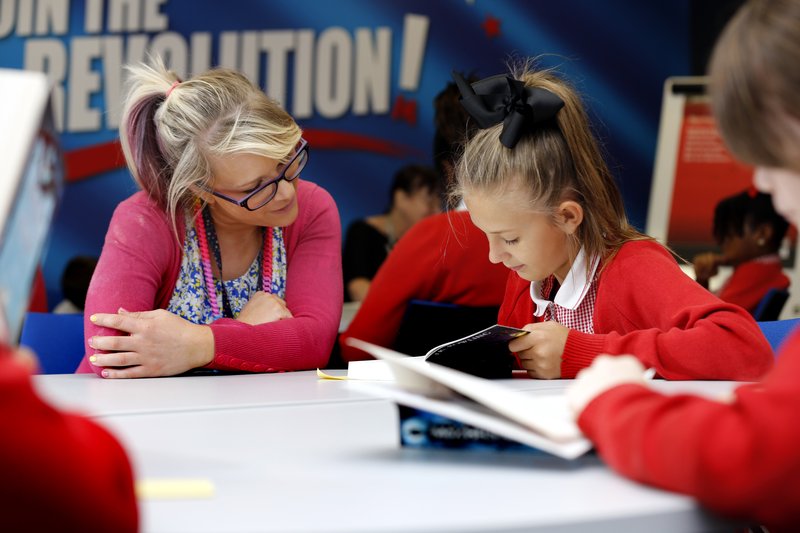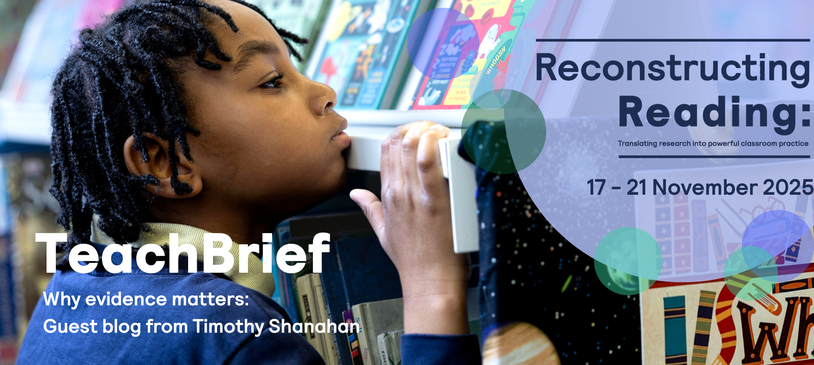This autumn, Reconstructing Reading: Translating research into powerful classroom practice invites educators to explore evidence-based strategies that enhance reading enjoyment and comprehension. Covering additional needs, EAL, digital tools, pedagogy, assessment, early literacy and more, this CPD event offers practical insights for curriculum planning and classroom teaching.
If you’re a teacher looking to cut through the noise and get to what really works in reading instruction, this event is for you. But how much of your practice is rooted in research?
In this guest article for TeachBrief, Timothy Shanahan - Distinguished Professor Emeritus and global literacy leader - explores the Science of Reading and why evidence-based instruction should be at the heart of every classroom. Plus, hear reflections from our Head of Professional Learning & Partnerships Martin Galway, on the importance of revisiting the mechanics of reading today.
Taking place 17 to 21 November, Shanahan joins us with not one but two keynote addresses for Reconstructing Reading – alongside a global line up of Dr Sinéad Harmey, Professor Natalia I. Kucirkova, Dr Jan Hasbrouck PhD & Dr Gerald Tindal PhD... and even more literacy leaders.
Don’t miss your place at the forefront of literacy research – grab your ticket here!
---------------------------------------------------
Introduction from Martin Galway, Head of Professional Learning and Partnerships
Huge thanks to Professor Tim Shanahan for allowing us to share this insightful blog exploring the Science of Reading, a term that leads to so many forms of discussion and debate.
The design of Reconstructing Reading is deliberate. Reading is rich. Reading is complex. It deserves more than reductive slogans or single-track conversations. Too often, discussions of reading - and even of reading research - become atomised, sliced into isolated components. Phonics here. Fluency there. Comprehension somewhere on the horizon. Necessary, yes, but not the whole story. We want to bring those threads together and make space for nuance without losing sight of what works in the classroom.
Our aim is simple: practical, accessible insight — rooted in evidence, driven by professional curiosity. A space to hold the big questions and still leave with something you can use tomorrow.
We do hope you can join us. Click here to book your place.
---------------------------------------------------

Before you change how you teach reading, ask: where’s the evidence?
Timothy Shanahan: What is the “science of reading?”
That depends on who you talk to. There is no agreed upon definition. Nor is there any official body like the Académie Française that can dictate a meaning by fiat. In 2020, Reading Research Quarterly published a science of reading issue online with more than 50 articles. There weren’t 50 definitions, but it was close.
The disagreements seemed to turn on two points: the role of instructional research and the scope of reading included.
Some use that term in reference to neurological and cognitive science studies of how brains process written words (e.g., Reading in the Brain: The New Science of How We Read by Stanislas Dehaene or Reading at the Speed of Language by Mark Seidenberg). The problem with that approach, as valuable as those studies can be, is that it ignores instructional research – the studies that consider the impact of how and what we teach. That wouldn’t be so bothersome if its purveyors weren’t trying to tell us what and how to teach while ignoring the direct evidence.
No one in medicine applies basic scientific findings to medical practice without intermediary tests of effectiveness and safety. Imagine physicians administering COVID vaccines without proof that they work.
Despite careful attention to basic research, only about 10% of medical therapies ever make it through the testing process. “Can’t miss” hypotheses based on terrific basic science research often fail to work in medicine and why would it be any different in reading education? A century of failed hypotheses in teaching (e.g. right-handedness training, learning styles, programmed readers, eye training) should disabuse us of this idea (Shanahan, 2020).

Effective reading instruction must be grounded in what works - not just what sounds plausible.
To me, a science of reading – if we are talking about education – requires that our prescriptions for teaching be tempered by rigorous instructional evaluations. If a claim hasn’t been tried out and found effective, then the claims – no matter how heartfelt – aren’t part of reading science.
Basic research shows that phonological activation takes place when people read words silently and simulations are showing that computers’ responses to words are affected by the statistical properties of the words they process. Such findings suggest that readers look for visual patterns when they read and that reading requires those patterns to be processed phonologically. That’s fascinating, but it doesn’t reveal how we can best teach reading.
As cool as those studies are, I don’t argue for explicit systematic phonics and phonemic awareness instruction because of them. I advocate such teaching because there are more than 100 studies showing that it improves kids’ learning (National Early Literacy Panel, 2008; National Reading Panel, 2000). Those brain studies, admittedly, strengthen the case, but without them I’d still teach phonics. Conversely, if I only had the brain evidence, then no deal – that should not determine our teaching routines.
When someone tells you what to do in the classroom based on a “science of reading,” be sceptical. Ask to see the research that shows that teaching those things or in those ways makes kids learn better.
Timothy Shanahan
Besides this fundamental dispute over the importance of instructional research in any effort to prescribe instruction, there was a disagreement as to what aspects of reading count as a science of reading.
Historically, science of reading has usually been used to refer to word reading or “decoding” in current parlance. If someone says your school isn’t aligned with the science of reading, they probably are saying that you aren’t teaching phonemic awareness and phonics like they think you should. There is nothing wrong or misleading about using the term that way.
But any science of reading instruction necessarily includes much more than that. Many of those Reading Research Quarterly articles aimed to expand the scope to include more than phonics teaching.
Much of the popular use of the science of reading term is specifically about phonics, but I don’t believe anyone disputes that other topics are part of this science as well, including vocabulary, reading comprehension, domain knowledge, oral language, and so on. Reading researchers shouldn’t feel threatened when someone says that science should dictate the inclusion of phonics instruction in a reading program. That in no way says that science shouldn’t be used in the same way with all the other complex of skills and abilities on which reading depends.

Buyer beware: not everything marketed under the Science of Reading banner is evidence-based.
How do I know if an instructional program or approach is part of a science of reading?
This question comes up a lot these days. And no wonder.
A couple of weeks ago I issued a blog that explained that some widely touted practices are not supported by science. You wouldn’t believe the messages I received from people angry with me for writing that. They assured me that those practices were supported by the science, and they knew it because they believed it.
I asked an author about this. She worked on a program that relied on some of those unproven practices, and it was being marketed under the science banner.
She knew there was no research supporting what she was selling. She defended her approach since, as she explained, it was “just logical that those things work given the science.”
She may be right about that. I don’t know. I do know that my hunches, biases, deeply held beliefs, and inklings aren’t science – and I don’t know how hers are so sanctified.
In fact, she was embracing not only practices that haven’t yet been studied, but even some that had been rejected by empirical research.
Unfortunately, the only real protection against such logical overreach is caveat emptor, buyer beware. When someone tells you that something is part of the science of reading, ask for the study or studies that proved it improved learning. Marshalling support for such claims shouldn’t be on the users’ shoulders but on those who make the claims.
References
National Institute of Child Health and Human Development. (2000). Report of the National Reading Panel: Teaching Children to Read: Reports of the Subgroups. Washington, DC: U.S. Government Printing Office.
Shanahan, T. (2020). What constitutes a science of reading? Reading Research Quarterly, 55(S1), S235-S247.
This is an excerpt from an article originally published 2 August 2025, kindly shared with consent from Timothy Shanahan. Read Timothy Shanahan's full article here.
---------------------------------------------------
Reading is never just one thing. It is skill and strategy, knowledge and culture, mechanics and evolutionary magic — all at once. Tim Shanahan reminds us that evidence matters, that instruction matters, and that what we choose to do with that evidence matters most of all. If this piece sparks ideas, disagreement, or fresh questions, well, that’s exactly the conversation we want. Join us at Reconstructing Reading to continue that conversation. Hear Professor Shanahan – and so many others - live, or via recording for your convenience. Leave with insight you can put straight to work in your classroom.
Martin Galway, Head of Professional Learning & Partnerships
Hear from Timothy Shanahan and our full lineup of international thought leaders at Reconstructing Reading, taking place online 17 - 21 November. Click here to see the full agenda and book your place!
